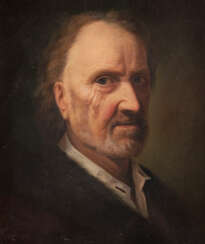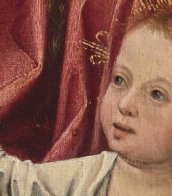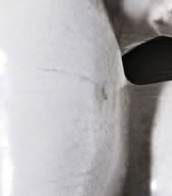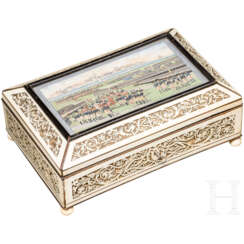balthasar denner

Balthasar Denner was a German painter, highly regarded as a portraitist. He painted mostly half-length and head-and-shoulders portraits and a few group portraits of families in interiors. Usually Denner concentrated on the face; clothes and paraphernalia were done by other painters or later his daughter. His chief peculiarity consisted in the fineness of his mechanical finish, which extended to depicting even the almost invisible furze of hair growing on smooth skin. He is particularly noted for his heads of old men and women.


Balthasar Denner was a German painter, highly regarded as a portraitist. He painted mostly half-length and head-and-shoulders portraits and a few group portraits of families in interiors. Usually Denner concentrated on the face; clothes and paraphernalia were done by other painters or later his daughter. His chief peculiarity consisted in the fineness of his mechanical finish, which extended to depicting even the almost invisible furze of hair growing on smooth skin. He is particularly noted for his heads of old men and women.


Balthasar Denner was a German painter, highly regarded as a portraitist. He painted mostly half-length and head-and-shoulders portraits and a few group portraits of families in interiors. Usually Denner concentrated on the face; clothes and paraphernalia were done by other painters or later his daughter. His chief peculiarity consisted in the fineness of his mechanical finish, which extended to depicting even the almost invisible furze of hair growing on smooth skin. He is particularly noted for his heads of old men and women.


Balthasar Johann Baptist Wiegand was an Austrian miniaturist painter.


Balthasar Johann Baptist Wiegand was an Austrian miniaturist painter.


Balthasar Paul Ommeganck was a distinguished Flemish painter, born in Antwerp, Belgium, in 1755. He garnered acclaim for his unique approach to landscape painting, blending realism with an idealized portrayal of nature. Ommeganck's work is characterized by detailed observation of nature, a sure line, and subtle use of color. His favorite subjects were undulating landscapes, often featuring grazing animals like cows, sheep, and goats.
Balthasar Paul Ommeganck's talent was not confined to painting alone; he was also a skilled draughtsman and dabbled in sculpture, producing some clay models of sheep and cows. His main contribution to art was combining the light found in Dutch Italianate painters' work from the 17th century with meticulous observation of nature, finding a synthesis between realism and an idealized representation of nature.
In 1799, Balthasar Paul Ommeganck's landscape painting won the first prize in Paris, a competition he had not intended to enter but was submitted to by a friend. His success extended beyond the borders of Belgium, as he became a member of several academies, including those in Amsterdam, Brussels, Ghent, Munich, and Vienna. In 1809, he was recognized as a corresponding member of the Institut de France.
Despite his death in 1826, Balthasar Paul Ommeganck's style continued to influence landscape painting in the 18th and early 19th centuries. However, later art critics have sometimes viewed his adherence to classic tradition and preference for the picturesque and conventional as a form of 'hopeless traditionalism'.
For collectors and enthusiasts of art and antiques, Balthasar Paul Ommeganck's works represent a significant period in the history of landscape painting. His paintings, with their fusion of realistic detail and atmospheric beauty, are a testament to his skill and vision.
To keep abreast of the latest news, sales, and auction events related to Balthasar Paul Ommeganck's art, consider subscribing to our updates. This service ensures you stay informed about opportunities to delve deeper into the works of this notable landscape artist.


Balthasar Johann Baptist Wiegand was an Austrian miniaturist painter.


Balthasar Johann Baptist Wiegand was an Austrian miniaturist painter.


Balthazar Moncornet was a French painter, engraver, and tapestry maker. He gained recognition for his engravings depicting various prominent 17th-century figures, contributing significantly to the art and culture of his time. His body of work includes a diverse range of subjects, from religious scenes to royal portraits.
One notable work is "Salome receiving the head of John the Baptist," an engraving that captures the biblical story with intense emotion and detail, showcasing Balthazar Moncornet's skill in creating compelling narrative scenes. Another significant piece is his depiction of "Saint John the Baptist," illustrating his versatility and mastery in etching. Additionally, Moncornet's "Park scene," though not visually available, is noted for its intricate details and artistic value.
His engravings were not just limited to biblical or nature scenes; he also produced works like "Louis XIII on horseback before a view of Nancy," highlighting his ability to capture historical figures and events with precision and artistic flair.
For collectors and art enthusiasts, Balthazar Moncornet's works offer a window into the artistic and cultural sensibilities of the 17th century, making them valuable pieces of history and artistry.
If you're interested in exploring more about Balthazar Moncornet's works or staying updated on related art sales and auction events, consider signing up for updates to deepen your understanding and appreciation of this artist's legacy.

















































































